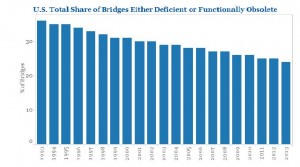
A recent study by Governing entitled “How Have Bridge Conditions Changed in Your State?” analyzed 20 years of data from the US Federal Highway Administration National Bridge inventory on bridges in need of repair. The report showed that from 1993-2013, the United States has seen a decrease in the total percentage of its bridges that are considered either functionally obsolete (built using outdated technology and has not been retrofitted) or structurally deficient (already has one or more decaying components).
But in the tri-state region, there is a different picture. The study revealed that as of 2013, there were 7,446 functionally obsolete bridges and 3,216 structurally deficient bridges across New York, New Jersey and Connecticut, compared to 4,536 and 12,134 respectively in 1993. New York and New Jersey have both seen a decrease of more than 50 percent in structurally deficient bridges in the last 20 years, though the total percentage of functionally obsolete bridges has significantly increased in these states. Connecticut on the other hand has only managed to improve its percentage of structurally deficient bridges by 6 percent since the early 90s, with 514 bridges currently in a vulnerable state – a trend that doesn’t appear to be improving.
The national percentage of bridges that are either structurally deficient or functionally obsolete has been steadily decreasing since 1993, as seen in the graph above . However, in New York, New Jersey and Connecticut, it appears that since the late 1990s, after an initial drop in the total percentage of bridges in need of repair, progress has stagnated.
Congress recently put off a permanent fix for funding transportation until May 2015. But if this report is any indication, elected officials will have to find a long-term fix to the Highway Trust Fund sooner rather than later if the country is to make substantial progress in maintaining bridges in a state of good repair.
